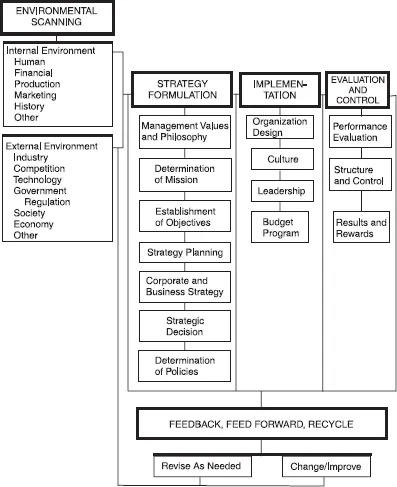![]()
Section I:
Strategic Management Framework
![]()
Chapter 1
Introduction to Strategic Management
The twenty-first-century realities of globalization, rapid changes in technology, increasing competition, a changing workforce, changing market and economic conditions, and developing resource shortages all increase the complexity of modern management. Whereas strategic planning was a competitive advantage in the past decade, it is a necessity of global thinking in this century. Planning strategically is certainly a new requirement in the global business world. In order to survive the new business challenge, global thinking and practice must permeate all corporate activities. Successful companies are, of course, the first to consider the global marketplace as their arena for competition. In addition, recent studies have concluded that organizations engaged in strategic management have outperformed those who do not.1 According to John Peter, strategic management has become a vital part of most, if not all, organizations. “Almost all organizations of any reasonable size have some kind of strategic planning.”2
Why is it Important to Study Strategic Management?
Traditional business disciplines—accounting, economics, finance—have been recognized for centuries. Management per se first appeared in the patriarchal familial structures of earliest civilization, with records of management following soon after. Hammurabi’s (2123 B.C.) Codification of Law mentioned accounting practices; Sun Tzu (600 B.C.) recognized such management techniques as division of labor, specialization, and the benefits of sound planning; Confucius (552 B.C.) advocated competition through merit systems while bemoaning the inherent problems of bureaucracy. In India, Kautilya (332 B.C.) wrote extensively about public administration techniques and the necessity of job descriptions.3 However, strategic management and business policy are relatively “foreign” concepts. Why? First, the subject matter is relatively new compared to traditional business topics. Second, strategic management and business policy integrates the traditional subjects with the main purpose of providing a practical, real-world view of business management.
The study of strategic management and business policy is a capstone course designed to integrate all prior learning into one subject suited for application in the modern business environment. Further, strategic management is designed to develop an awareness of the processes by which organizations can achieve synergies of the whole through the effective cooperation and interaction of the many departments within an organization. Today’s managers must have and/or develop the ability to see the interdependent and interrelated nature of organizations. In addition, managers must develop the necessary skills to closely interact with people from differing backgrounds. Therefore, the study of strategic management is designed to prepare current as well as future managers to meet the challenges of today’s competitive and ever-changing environments.
History of Strategic Management and Business Policy
The study of business policy is relatively new, and the discipline finds its roots in the early American business colleges. Harvard started a course similar to Business Policy in 1911 and, by the 1920s, required it for second-year students. Harvard hoped to demonstrate how the internal and intradivisional functions of business were closely interrelated in practice and how top management had to recognize and manage these interrelationships to work effectively and efficiently.
In 1959, a Ford Foundation and Carnegie Corporation-funded study indicated that business school curricula resulted in various disciplines with course content that students understood only in isolation. The study found that when students were presented with problems requiring integrated subject matter, they had trouble applying the individual course content to the business as a whole entity.4 In reaction to this study, the American Assembly of Collegiate Schools of Business (AACSB) launched the business policy course as an organized capstone course intended to provide an important and lasting role in schools of business. Subsequently, the field of business policy passed through an evolutionary process and today business policy course content is again evolving into the study of strategic management.5 This new field contributed to other business disciplines such as management, marketing, accounting, and finance, among others.
According to Gluck, Kaufman, and Walleck, strategic planning and strategic management evolve through four consecutive phases.6 Increasing change and complexity in the corporation’s external environment most likely cause the development of these phases. The first phase involves developing the annual corporate budget. This is called financial planning. At this stage the company collects information internally, such as this year’s sales and next year’s expectations. Also collected is information about personnel, production capacity, raw materials, and other related matters.
The second phase is similar to the first except the plan covers a longer period, three to five years. This type of planning is called forecast-based planning. This stage involves collecting information from outside the organization but on limited scale.
The third phase of planning, called externally oriented planning or strategic planning, is developed mainly by top-level management with the help of consultants. At this stage the company collects information about the external environment and the changes in its competitive market. The main criterion of this stage is the top-down approach to planning. This type of planning does not focus on implementation, which is left for lower-level management and employees to discuss. The third phase also features long-period forecasting, five years or longer.
The final phase is the strategic management approach, in which all management and key employees participate to develop a sequence of strategic plans to achieve the various objectives of the corporation. At this stage a comprehensive analysis of the corporate external environment takes place.
Purpose of Business Policy Course
To understand why Business Policy is taught, one needs to examine what is learned in the course. Business Policy provides practice in decision making (DM) because it primarily covers the job of the general manager and analyzes potential problems from the perspective of the business as a whole. It provides decision makers with the needed information to pursue clarity, accuracy, greater consistency, and speed in the DM process.
The course offers the views of general management. Therefore, instead of getting a functional or operational point of view, the student receives an overall point of view, from the top of the corporation. The course enables the student to develop an eagle-eye perspective that a chief executive officer (CEO) requires in order to be successful. During the course, the student will analyze a wide range of business policy cases, which will help the student acquire a much broader general knowledge about business practices domestically and internationally. Because of this wider view, the student’s creativity and imagination will be additionally stimulated when faced with real problems in working situations.
The central theme of the business policy course is corporate strategy. Strategy is not a theory but is the corporation’s general approach to achieve its mission and objectives. The strategic management process is important, not only for top-level management, because it filters down to the middle and operating levels as well as the shop floor employees and their supervisors. An understanding of domestic and international competition is important to everyone involved in the organization. Understanding the strategic process can provide employees with direction as well as the needed incentives to work hard and be more competitive.
The course stresses the development of the top manager’s ability to relate the processes of management to the common problems that top managers face. This is probably the reason that most of the exercises completed by the student consist of case analyses. Analyzing cases enables the student to utilize processes and theories learned in earlier courses to strategically solve problems from an organizational standpoint.
Business Policy has been designed to create an awareness of and an interest in the strategic problems of a business and its relationship with society. It is hoped that students will learn to evaluate both qualitative and quantitative evidence when conflicting points of view are encountered. This course will teach a student to become proficient at decision making, while learning all the basic concepts in the field of business policy and strategic management.
Strategic Management Models
Scholars feel that the strategic management process is best understood and applied using models. Therefore, several strategic management models have been introduced. Each model has several components that are interrelated, dynamic, and continuous. A change in any of these components may result in a change in other components. For example, the company’s objectives and strategies may change if it obtains a new technology or other capabilities that improve its competitive advantage. Therefore, the four major elements of strategic management (environmental analysis, formulation, implementation, and evaluation and control) should be considered interrelated and continuous. These models do not guarantee success. However, they do represent a clear and practical approach to formulating, implementing, and evaluating control strategies. Although different models exist, they do have common elements. Almost all of the models focus on the environmental analysis of the organization. Most of them start by identifying an organization’s mission, goals, objectives (hierarchy of purpose), and the various levels of strategies (hierarchy of strategies). Understanding the organizational environment and its hierarchy of purpose will help the company to adopt or avoid certain strategies in order to take advantage of the opportunities in its environment. By understanding the previous strategies of the organization and assessing its current position in the market, management can better forecast the future.
Most scholars present a clean picture of how these various elements relate to each other and how they should work. It is important to understand that the strategic management process is more complex than a simple drawing of a relationship. To ensure success in the formulation and implementation of any strategy, everyone in the organization must be involved. Operating-level management and employee involvement and feedback are essential to any strategy. Since competitive position is dynamic and ever changing, the means to support the competitive position of today’s organization must be comprehensive and relevant because the organization must deal with the global aspects of the business environment. Relevancy involves the analysis of current and potential competitors inside and outside the industry. Strategy needs to be developed by talented individuals who are familiar with corporate internal and external realities, who should consider the global marketplace as the proper domain of analysis. You cannot have an effective strategy unless each of the other managers and employees of the organization participates in his or her capacity.
In this book, the strategic management framework consists of four connected, dynamic, and continuous elements: environmental analysis, strategy formulation, strategy implementation, and evaluation and control. Although each of these st...

